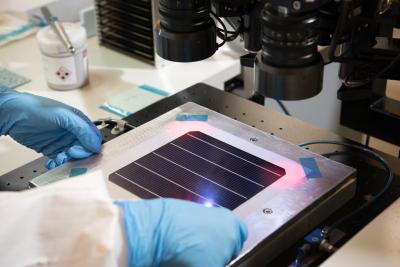A team of scientists from Technische Universität Berlin, Oxford PV Germany, German Philipps-Universität Marburg, Helmholtz Zentrum Berlin (HZB) and Oxford PV UK has, for the first time, assessed the environmental performance of industrially produced perovskite-on-silicon PV modules. Understanding the environmental impact of solar PV modules across their entire lifecycle is essential for the design of more sustainable solar energy systems. However, lifecycle assessment of perovskite-on-silicon PV modules has so far relied heavily on data from laboratory and test facilities rather than manufacturers.
The researchers conducted a comprehensive lifecycle assessment of a perovskite-on-silicon module across a number of categories including global warming potential, water consumption, human and marine toxicity, and metals usage. They assessed the materials and energy input for a module’s ‘cradle to gate’ lifecycle, covering all materials and energy input for wafer production, manufacture of the perovskite cell, and module production. The researchers then weighed up the environmental impact of the tandem module against the electricity generated over its lifetime.
“We have found that perovskite-on-silicon PV modules are more environmentally advantageous than conventional silicon heterojunction modules over a 25-year lifetime,” says Bernd Stannowski from Helmholtz-Zentrum Berlin, a co-author of the study.
“We found that the perovskite-on-silicon module has 6% to 18% less environmental impact than a silicon module, when we consider the additional energy generated over the tandem module’s 25-year lifetime,” says Martin Roffeis, co-author from The Technical University of Berlin.
The tandem module used in the study would generate the same amount of electricity in 22 years as the referenced silicon heterojunction module over 25 years.
“The higher power conversion efficiency of the perovskite-on-silicon tandem module compensates for its environmental impact due to the additional perovskite material and processes,” notes Jan-Christoph Goldschmidt, co-author who carried out the study while at the Fraunhofer Institute for Solar Energy Systems, and who is now at The Philipps University of Marburg.
The study also finds that the environmental performance of a perovskite-on-silicon module is largely influenced by energy consumed during the production of silicon wafers.
Oxford PV provided the perovskite-on-silicon module and process data for the study from its volume manufacturing line in Germany.
“The sustainability of solar materials and supply chains is growing in importance as the world deploys solar at the multi-terawatt level,” says Laura Miranda Pérez, Head of Materials Research at Oxford PV. “We hope our contribution will help industry and the wider scientific community to improve the design, production, and end-of-life management of tandem technologies, supporting their rollout.”




